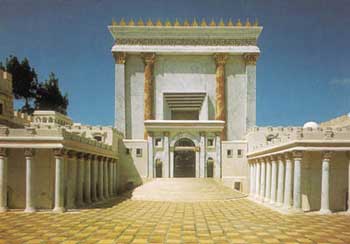Let’s face it. The next 8 chapters of temple measurements are not the most obvious as to their purpose.
Ezekiel is taken in a vision and sees an angelic being with a measuring guide. The angel then gives him exact measurements of the temple. But why?
Is this literal for a time of rebuilding in the distant future? It was not the measurements of the temple that was rebuilt in Nehemiah’s time. But was it for a temple in some very distant future? Possibly in a millennium?
Is it figurative for the perfection of the temple and worship?
Is it apocalyptic of Israel’s future? To give them a hope that they would be restored?
There are problems and possibilities with each of these. We know from Hebrews that Jesus is the high priest and that he is the fulfillments of the temple. There is no longer a need for animal sacrifices or even high priests. But does this mean that there isn’t a central place of worship of Jesus?
It’s not easy to understand the purpose of this vision. What we do know is that it would have given hope to Israel. As a people in captivity who felt the center of their lives, the temple, was destroyed, this vision is about a new temple being constructed. Whether that is literally, figurative, dispensational, or apocalyptic, it was a message of hope.
And that is something we find several times in Ezekiel and in the major prophets. God gives his people hope that one day they will be restored. When you are suffering and it is a very long period of time, hope starts to fade and despair sets in. A vision like this would be one more huge boost of hope. And for me, I think that is the main purpose—giving hope to those in exile that there will be a restoration one again.
In this chapter we see several measurements
- The outer court
- The inner court
- The area of sacrifices
- The area of singers and the serving Levites
- The portico of the temple
The outer court and its walls were to create a separation from the normal world of outside and the protected world of the inside, such as any city in ancient times. This is where the reign of God was.
The inner court was nearing the place of worship. The sacrifices and such were done there. This was a step closer to the heart of God.
Then they’re the singers. This is the place of worship. But it is also the place of the Levites who served at the altar and other parts of the sacrificial ceremonies. This was all about worship.
And then there was the portico. This was the porch with pillars that led into the holy place and the Most holy place. The porch and the entryway mattered as one comes to the place of meeting with the Lord.
While the temple was fulfilled with Jesus, there is the concept that remains. We can approach the throne of grace with boldness as we read in Scripture, but there is also a graduating reverence and holiness that takes place as we near the presence of God. It is the place of separating ourselves from the outside world, receiving the sacrifice of Jesus on the cross, its worshipping God, and approaching his grandeur going upward to meet him. There is a sense where these things are eternal.
And I wonder, and ask myself, how is it that I myself approach God? Separating myself from the world’s systems and ideals, cleansing my heart in repentance with the sacrifice Jesus gives, worshipping him, and approaching with respect and reverence?

